A couple of days after I wrote about “Caga Tio” – the traditional character made out of a rough-hewn log that is believed to “shit” presents in homes all over Catalonia, Spain on Christmas morning, I met up with my friend and fellow travel blogger, Isabel Romano in Barcelona. She and her significant other, Xavier, had read my post and decided I’d learned only part of the story. So after a Sunday morning breakfast of hot chocolate and churros, we were off to Cathedral Square to visit the city’s annual Christmas Market, where I would learn about the unbelievably weird tradition of the “el caganer.”.
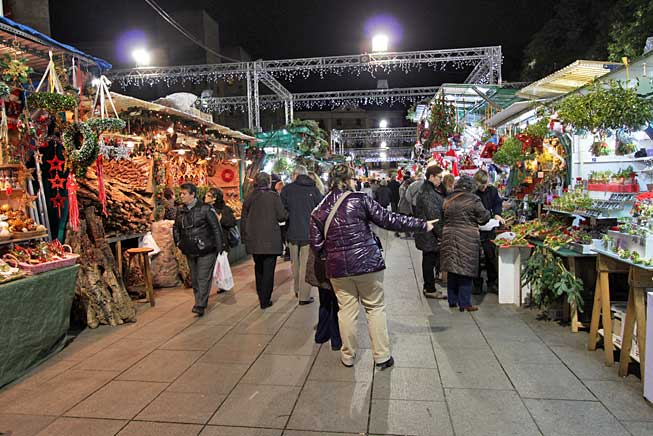
Isabel and Xavi explained that rather than decorating a Christmas tree each year, Catalonians buy a nativity scene, called a Belen in Spanish and a Pessebre in Catalán. Often, these nativities consist of a complete pastoral scene with a traditional Catalán farmhouse or even an entire village. Each year, families scour the market for new pieces to add to their nativity. Up and down the aisles, booths were filled with everything from basic manger scenes to elaborate miniature buildings, trees, rivers, mountains, farm animals and figurines. I was perusing a selection of Joseph, Mary, the wise men, shepherds, and baby Jesus when Isabel pointed to a large sign atop one booth that said “El Caganer.”
“There is a Caganer hidden in every Belen,” she explained. “He wears the traditional Catalán hat called a barretina and is always displayed squatting with his pants around his ankles, defecating.”
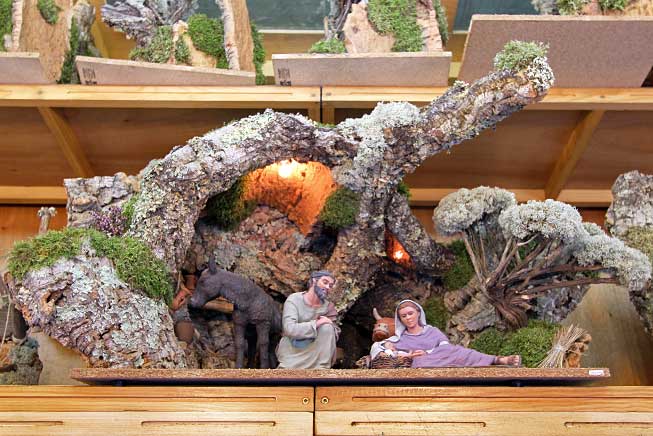
Catalonian Christmas traditions are certainly mystifying, if not downright bizarre. No one knows for sure how El Caganer originally came into being and even today, opinions are divided on what it symbolizes. Some insist that excrement is symbolic of fertilizing the earth. According to the ethnographer, Joan Amades, it was a “customary figure in pessebres in the 19th century, because people believed that this deposit fertilized the ground of the pessebre…placing this figurine in the pessebre brought good luck and joy and not doing so brought adversity.” Others insist that the act of defecation is symbolic of the equality of all people, regardless of status, race, or gender (everyone does it). But the explanation I like best is the allusion to an old Spanish proverb which translates as “Dung is no saint, but where it falls it works miracles.”
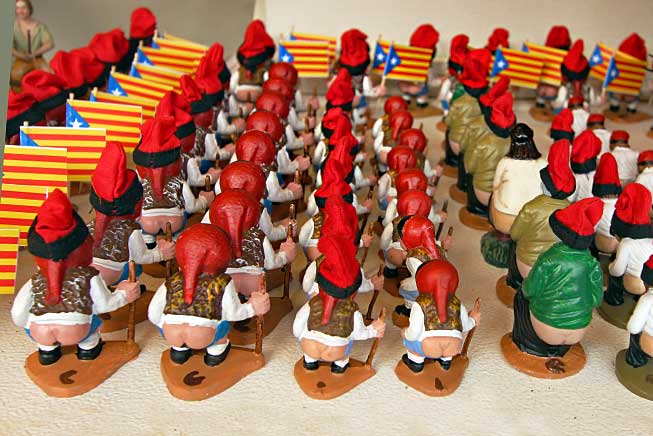
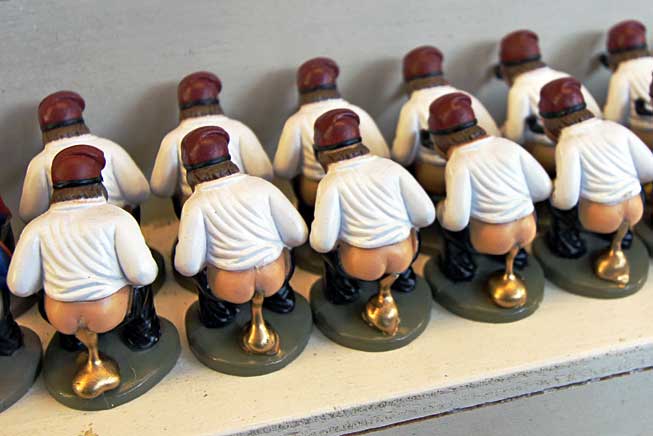
Today the Caganer has become so popular that it is reproduced with the faces and dress of many famous people. Among the defecating figurines I identified were Queen Elizabeth and Prince Charles; Michael Jackson, Elvis Presley and John Lennon; the entire Barcelona fútbol (soccer) team; Winston Churchill, Martin Luther King, Jr. and Margaret Thatcher. And lest you wonder, President Obama had his very own Caganer within days after winning the first presidential election in 2008.
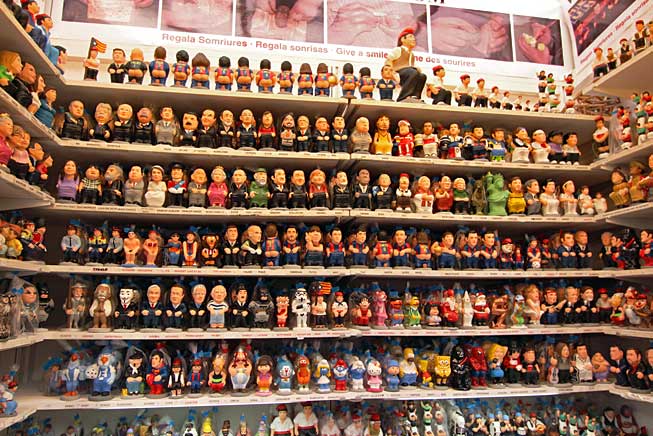
But even that’s not the end of it. As with most places across Spain, the Catalonian Christmas season culminates with Dia de los Reyes Magos, or Three Kings’ Day, more commonly known in the U.S. as Epiphany. According to Spanish tradition, gifts are exchanged on Epiphany rather than Christmas Day. On January 5th, the three wise men (Magis or Kings) are transported through the streets on elaborate floats during a three-hour long parade, during which tons of candy are tossed into the hands of spectators who line the route. That evening, children all over Spain clean their shoes and leave them out on window sills or balconies, filled with snacks for the Kings and hay for their camels. In return, the Magi fill the shoes belonging to well-behaved children with presents; ill-behaved children receive a few pieces of candy that resemble – wait for it – camel turds.

Nice article, thank you. However, this tradition is not only in Catalonia, but we have the Caganer here in all the Beléns in the Canary Islands, too. It is always fun with a bunch of friends to see who can spot him first. ?
Hi Barbarella. Thanks for letting me know. One of these days I’m going to have the opportunity to try and spot him in person.
Stunning work, thank you so much for taking the time to share!
You’re welcome Abedin. Glad you enjoyed my story.
wow!!!!!!!!!!!!!!!!!!!!!!!!!!!!!!!!
Thank you for sharing this wonderful blog!…
All the pictures are good…….
Hi Barbara, I found your blog through Brett and Mary’s Green Global Travel Blog. They speak highly of you.
Can’t get over the Caganer 🙂
Hi David: So glad to have you as a reader and lovely to hear Brett and Mary speak highly of me. I think the world of them as well. Catalonia, Spain has some pretty unique traditions; I was there for about a month and frankly, don’t think I even scratched the surface 🙂
I love hearing about all these different cultural traditions. Although the Caganer got a little sidetracked by putting on famous faces, I wouldn’t mind someone leaving golden gifts 🙂
Ah, if only they were gifts of gold. I could use a little of that myself, Fida 🙂
Bizarre.
I don’t buy the fertilizing the earth excuse though. My neighbor would definitely call the police if I fertilize her garden that way.
Iskander – you gave me my laugh of the day. Pint well taken.
Hilarious! Now I won’t rest until I own a caganer. Guess I’ll have to return to Catalonia. I’m excited to discover your inspiring blog. I took my solo backpacking trip around the world when I was 35 and continue to travel as often as possible. I’ll be 50 next year. You go, girl!
Thanks so much Cara! Always makes me happy to hear I’ve inspired someone in some small way.
Ok, now it sounds even more ridiculous! Those little statues are hilarious! Thanks for sharing this tradition with us.
Hi Ali: And I haven’t even talked about the crazy tradition of eating 12 grapes for each strike of the clock at midnight every New Year’s Eve. Catalonia, Spain is a fascinating place!
I brought word of this tradition (and Caga Tio) home from Spain last year. Tio was the hit (literally) of my between-Christmas-and-New Year’s party!
Love to know what you did Krista – did you set up a Caga Tio and have everybody beat the gifts out of it? 🙂
Awesome! …and of course even more controversial than the shit-log of the previous post! In Germany there’s no poo and pooing people in Christmas (although I don’t really know each and every village everywhere, so who knows) but reading your blog-post I started getting dizzy because it felt like somebody put a bunch of traditions in a bottle and just shook them, until the craziest combinations came out of it. You see, on the night before the 6th of decembre, German children leave their empty (and polished) shoes outside their rooms, for some guy called Saint Nicholaus to be the judge of how well they behaved during the year and to reward them. If they have been good, they’ll find it full of candy the next morning; if they have been bad, there’s either nothing or something unpleasant in it. So much for the empty shoes. Next: in spring, several regions celebrate “the fifth season”, Karneval, where people dress up and have parades (originally to chase winter away), where they throw candy. And we also have the three kings come around in January, although only to bless each house. Now I’m thoroughly confused. What is even REAL anymore?
Hi Vera: The more I hear about holiday traditions around the world, the more fascinated I become. It has all the makings of a best-selling book!
A little difficult to identify with this Christmas tradition but then we hide money in the Christmas pudding and offer coal at the door at New Year